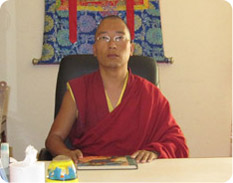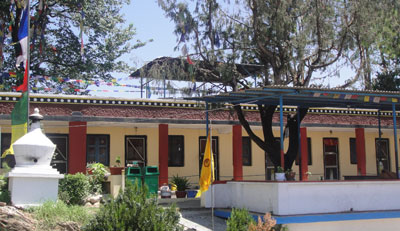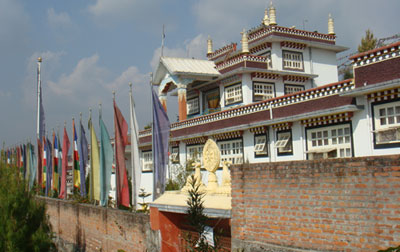Namo Buddha Meditation and Education Centre
Namo Buddha Preliminary Retreat
Retreat Master: Lama Yonten
 Lama Yonten has been involved with the clinic for the past twelve years. His father and mother are from east and west Tibet, respectively. He joined Thrangu Monastery at the age of fourteen. Entering the monastery, he learned religious practice and ritual, then undertook six years of Shedra study (higher studies in Buddhism) at Namo Buddha. He completed the three-year retreat at Bhaktapur Thrangu Sekhar retreat centre. |
 To the north of the main temple is a retreat center with twelve rooms and a temple. Construction of the monastery was begun in 1978, and from then until 2000, five three-year, three-month retreats were held there. Subsequently, a new retreat center named Thrangu Sekar Retreat Center was constructed near Bhaktapur, close to a place where Milarepa had practiced. At the original retreat center monks now engage in the preliminary practices of the five sets of one hundred thousand repetitions.
To the north of the main temple is a retreat center with twelve rooms and a temple. Construction of the monastery was begun in 1978, and from then until 2000, five three-year, three-month retreats were held there. Subsequently, a new retreat center named Thrangu Sekar Retreat Center was constructed near Bhaktapur, close to a place where Milarepa had practiced. At the original retreat center monks now engage in the preliminary practices of the five sets of one hundred thousand repetitions.
The main practices of the three-year three-month retreat involve the path of means (the six yogas of Naropa) and the path of liberation (the Great Seal). The retreatants also accumulate man
tras in meditating on Chakrasamvara and other deities, and they practice the guru yoga of Marpa as well. But retreat is not just about counting up numbers. There are initiations that mature, commentaries that liberate, and reading transmissions that lend support so the mantras are repeated in accord with these three to make them authentic. As Vasubandhu wrote:
By listening and reflecting while maintaining discipline,
You will perfectly connect with meditation.
 Thrangu Shekhar Retreat Centre is located just below a famous cave where the Tibetan yogi Milarepa stayed in meditation. The place is known as Saraswatithan and is located in the hills above the ancient town of Bhaktapur which was once a Buddhist Newar kingdom.
Thrangu Shekhar Retreat Centre is located just below a famous cave where the Tibetan yogi Milarepa stayed in meditation. The place is known as Saraswatithan and is located in the hills above the ancient town of Bhaktapur which was once a Buddhist Newar kingdom.
The Retreat Centre has two separate sections for the retreatants so that two separate three-year retreat groups can stay at the same time. Each section has its own prayer hall.
Vasubhandu also spoke of practice: "By receiving vows and by correctly listening to and reflecting on the teachings, one will perfectly connect with meditation." In the presence of khenpos and special teachers who have the two qualities of being stable and expert, a person suitable to receive the three stages of the vows takes the layperson's vows and/or novice or full ordination either for this lifetime or until enlightenment. One then needs not only the knowlege that comes through listening and reflecting, but also all of this has to be brought into one's experience. Situ Chokyi Jungne said: "Knowing the view but not being able to meditate is like a rich person bound by stinginess: the result required for oneself and others does not emerge."
Generally, it is excellent to know what the genuine Dharma is. However, if one does not meditate, the ultimate result will not be obtained. So, practice is very important. Further, rather than practicing alone in a solitary place, it is better to practice in a group. Repa Shiwa has said: "The basis of virtuous activity is compatible Dharma friends." Through the encouragement of lamas and virtuous friends who truly follow the Dharma, faith and diligence grow, and laziness and discouragement are turned around. From the time of being a beginner, one must practice according to the stages of the path. So that Dharmic habitual tendencies arise and remain stable, one first begins with the common preliminary practices of the Four Reflections, meditating on impermanence, and so forth.
The very basis of all paths is refuge, which is recited along with prostration. The purpose of Vajrasattva practice is to pacify negative karma from the past, present afflictions, and coarse conceptualizations. The purpose of mandala practice is to gather the accumulation of merit that creates the right circumstances for experience and realization to arise in one's mind stream. Another method to accumulate merit is done by the "practice of cutting though": one practices the general and specific guru yogas. Mind training is to give rise to the special motivation of loving kindness and compassion and to give rise to bodhicitta where it has not arisen and, where it has arisen, to practice so that it does not decline but develops further. One meditates on the equality of oneself and others, on exchanging oneself for others, and that others are more important than oneself. Those are the preliminary practices.
The main practices are from the great classes of tantra with the general practice of the generation stage of the yidam deity, and specially, those practices Lord Marpa Lotsawa received from Naropa. In one of his songs. Marpa said: "I received Hevajra, the profound tantra, and Chakrasamvara, the heart's essence." According to this, the generation stage of Chakrasamvara is the heart and the heart's essence. Further, there is the practice of the aspect of the father, who is skillful means, and the aspect of the mother, who is wisdom. Of these, it is the practice of Vajrayogini that mainly emphasizes superior wisdom and primordial wisdom. It comes from the whispered lineage. The generation stage is brought to perfection based on the accomplishment of the outer, inner, and secret practices. The completion stage is practiced based on the profound path of method, including the practices of nadi, prana, and bindu found within the Six Yogas of Naropa. On the path of liberation, after having been introduced directly to the nature of the mind itself, one practices mahamudra.
So that one does not get lost in mere talk, dry understanding, or mere study, nor in a fool's meditation, blind faith or a mistaken path, one then receives empowerments that mature, explanations that liberate, and reading transmissions that support. The necessity of staying in retreat is so that the lineage will not in any way deteriorate and, in particular, that the practice lineage's blessing remains unbroken. In three years, the best retreatants fully accomplish practice; the average one attains qualities, such as the signs of heat, and the lowest one without error, takes hold of the beginning of the path leading to liberation and omniscience. In this way, retreat is endowed with many special benefits.
This was written by the one with the name Thrangu Tulku. May it be a cause for the flourishing of the teaching on study and practice.